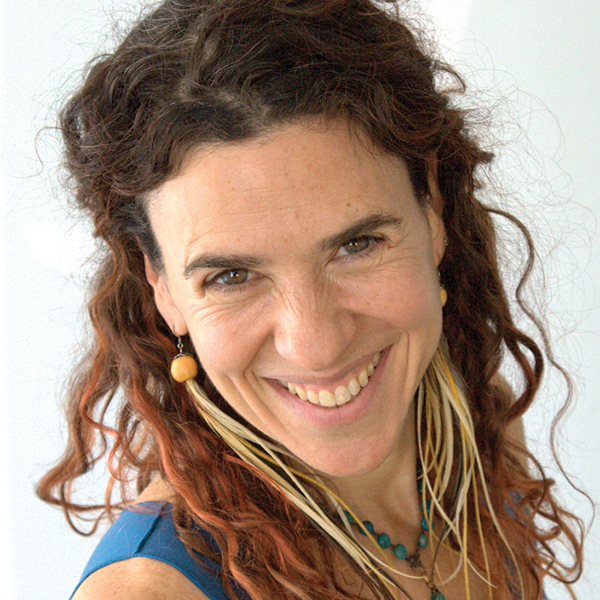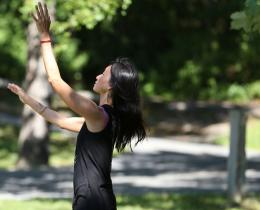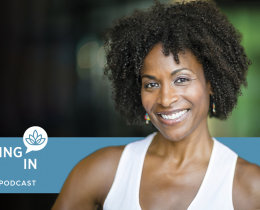Omega: How did your personal journey with dance start?

Toni: My introduction to dance was bad. By about age 8 or 9 in a ballet class, I said, “I don’t ever want to do this again. I hate dancing!” As I got older, I started dancing in clubs in NYC. I took modern dance in my 20s—Simonson jazz, African dance, and some Limon technique. I was always a crazy wild dancer and not so good at following steps or instructions. But I loved the music and the movement.
For me, there has always been this inexplicable relationship with the way music affects my body.
Omega: When did your passion for embodied movement kick in?
Toni: This passion actually came out of pain. I had been carrying a lot of different pain points from my family, specifically from one of my sisters. I learned early on to hate my body and I didn’t know how to handle my emotions. I developed an eating disorder in my teen years. I would stuff my emotions and then purge them out. In my later teen years I became the aerobics queen and then I got seriously into yoga and fitness in my 20s. It was all about perfecting myself.
I had my first cathartic embodiment moment in a Kripalu DansKinetics class, which was free-form dance with no mirrors. I remember when the teacher said, “You are all so beautiful.” I felt it. We got into child’s pose after dancing, I had this heaving release—that kind of cathartic grief when you just let it all go.
I heard another voice in that moment and it was my own. “You are never going to the gym again. You are never going to purge again. You are never going to harm yourself again. I love you.” That’s when I submerged myself in the embodied healing and dance world.
Omega: Tell me the story of how JourneyDance was created.
Toni: In 1995, one of my teachers, Nateshvar (Ken Scott) looked me in the eye, and I knew I was getting a transmission. He said, “Toni, you can do whatever you want with this dance.” I knew he was giving me the freedom I needed and JourneyDance was born within a year.
I began to bring all the parts of myself into this creation. I had people roll around on the floor because of my background in contact improv. I added pelvic and spinal work from yoga. The other part of me that had never come to the dance floor was my whole theater life. I had been studying playback theater, psychodrama, and shadow work, and I began to incorporate it. I had already gotten a masters in education at NYU, but now I would teach what I love.
Omega: How is JourneyDance different from other ecstatic dance?
Toni: JourneyDance has a guide who leads you on a ritual journey of physical and emotional transformation. It’s not about learning steps or choreography, it’s about revealing, recovering, and re-discovering your natural intuitive movement. JourneyDance takes you through a transformational arc, which include embodiment, sensual awakening, enlivening our playful self, exploration of inner realms, empowerment, alchemy, and expression.
Omega: What is your goal with JourneyDance? Who are you looking to reach?
Toni: My goal is to help people feel belonging. To help people reconnect to their joy, their energy, and their passion for life. I want to encourage people not to stay isolated with their trauma and emotional pain or disconnection. It’s really for anybody who needs to release something or move some energy. We can all dance together, and “tell your story to the dance floor” (my tagline) and be held in community.
There is something very healing about being heard and being listened to. Sometimes we think we have to talk everything out, but I believe so much can be expressed and released with movement.
Omega: So JourneyDance is a tool for emotional processing?
Toni: The truth is, we are not educated in how to handle our emotions. Even through all the schooling, if you don’t have a parent or adult who knows how to model it, you will not learn how to process and handle your big feelings. And you will bump around from relationship to relationship trying to figure out what to do with your emotions. But emotions are how we respond to the world!
So in JourneyDance training, if someone starts crying, we don’t dive on top of the person and give them a box of tissues. That’s not what we want, we want to let emotion flow, even if it’s messy. So we say, “How wonderful!”
Emotions need to express and move. They are meant to be energy in motion. JourneyDance is a way of helping emotions release and move through, leaving us feeling expressed, freer, and lighter.
Omega: You like to use the word weird. Why is that?
Toni: I love it! I have a thing I teach on the dance floor called the, “Do you want to be perfect, or do you want to be weird?” dance. I say, “Ok, Be perfect!” and everyone stiffens up and goes up on their toes with their noses in the air. Then I say, “Now be as weird as you want,” and they just get free!
You realize being weird is so much more fun, and it’s easier. Being perfect is a terrible torture and has created so much trouble in the world. People are afraid to be weird because they think they are going to be embarrassed. It takes so much energy to keep everything perfect and it’s such a part of our conditioning. We end up not even being real. That’s no way to live! So instead, I do the opposite and get super weird. We all get weird together and it’s so fun and freeing.
Omega: How did The Remedy come about?
Toni: This pandemic has taken a toll on people, especially when it comes to isolation and connection. When my weekly JourneyDance classes moved online, people wanted to hang out on Zoom afterwards and connect. So, alongside vocalist and JourneyDance leader Joy Okoye, we developed a weekly program where we moved together, wrote, and then shared our writing in community.
We need more practices and processes that bring us into an embodied state of feeling. If we can’t hold our own pain, we cannot hold other peoples’ pain. If you can’t feel, you cannot be empathetic. Empathy is how we connect. And connection is how we heal. When you take a program like The Remedy, you can really feel everybody else’s story and say “Wow, these people are brave and courageous! And I can be, too.”





